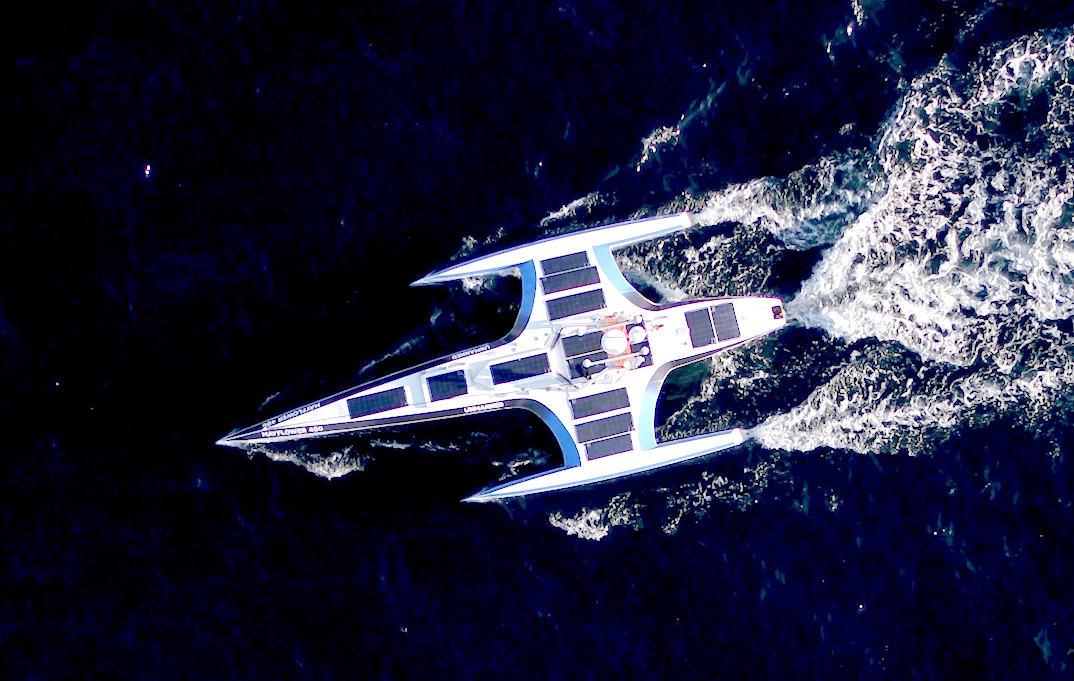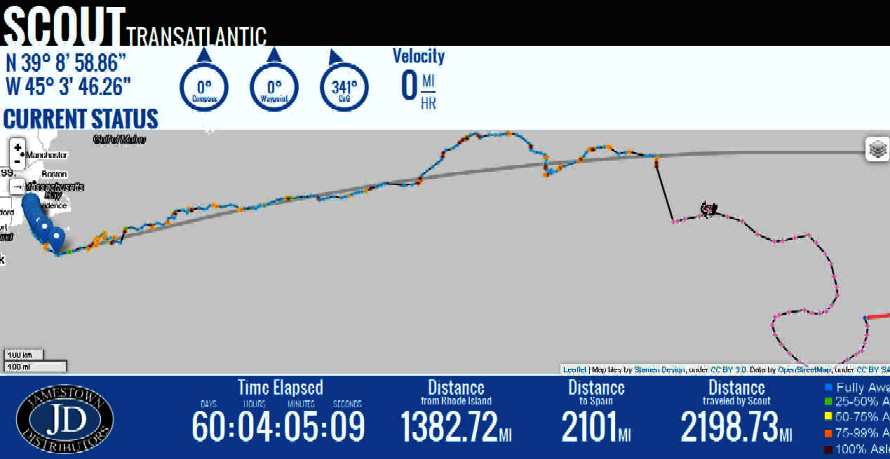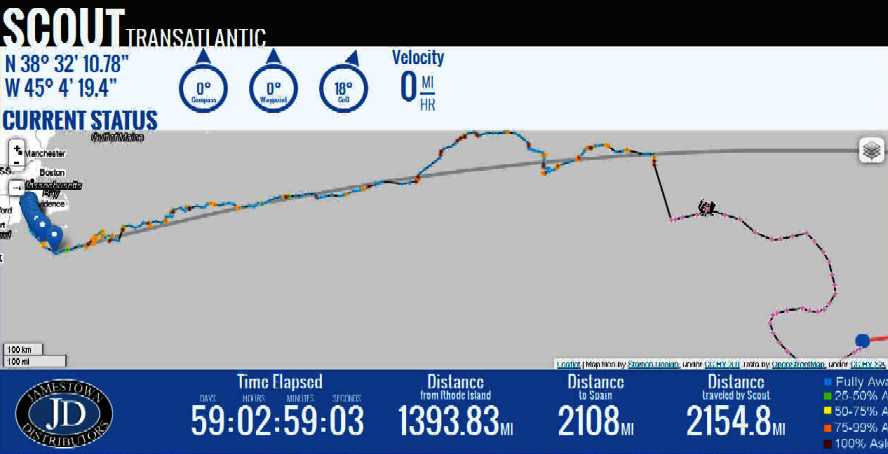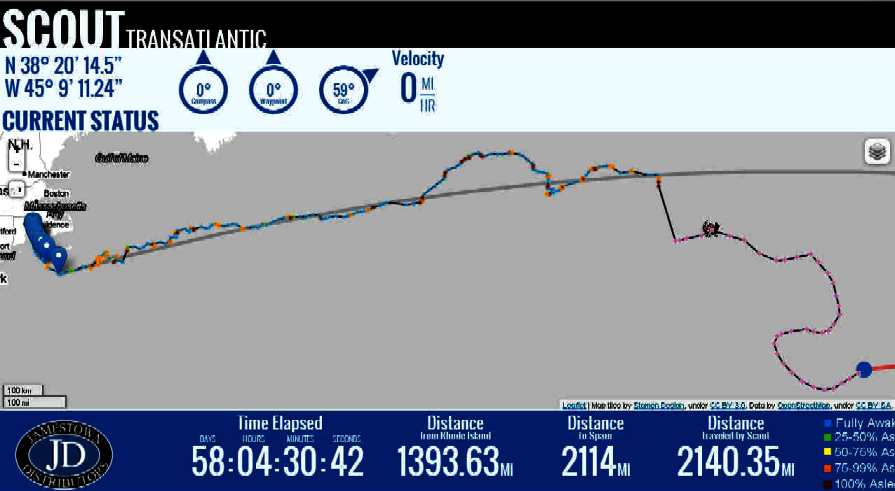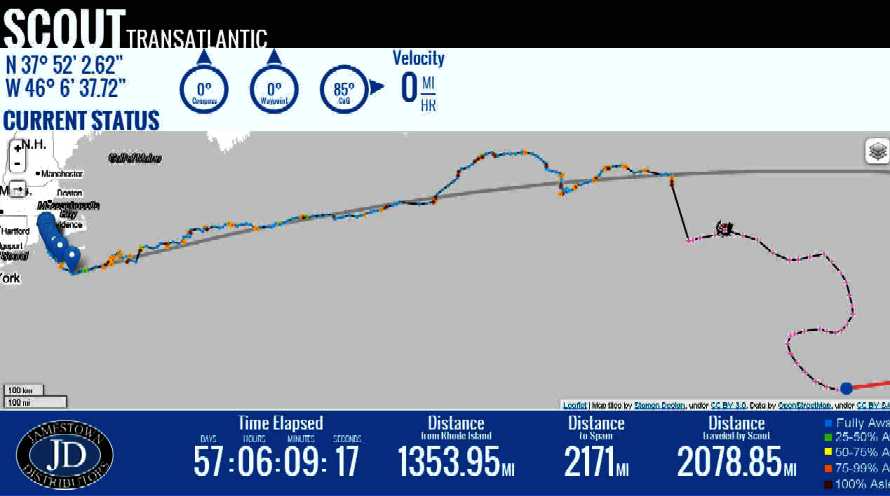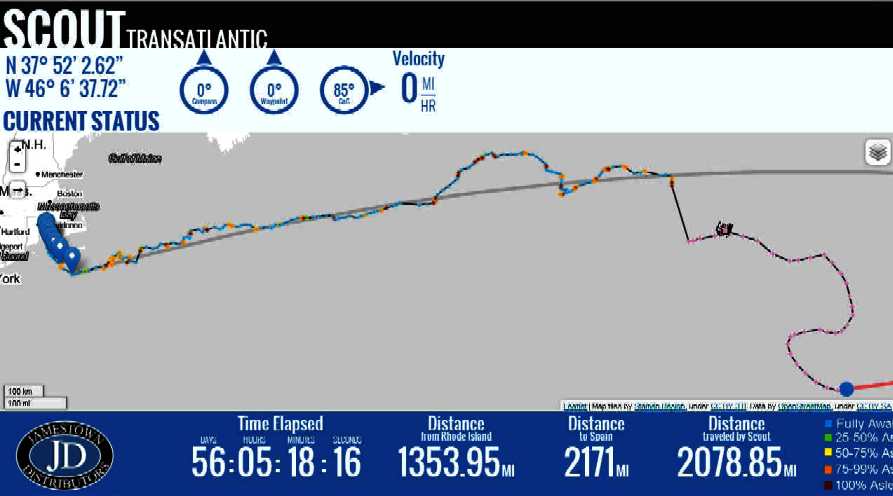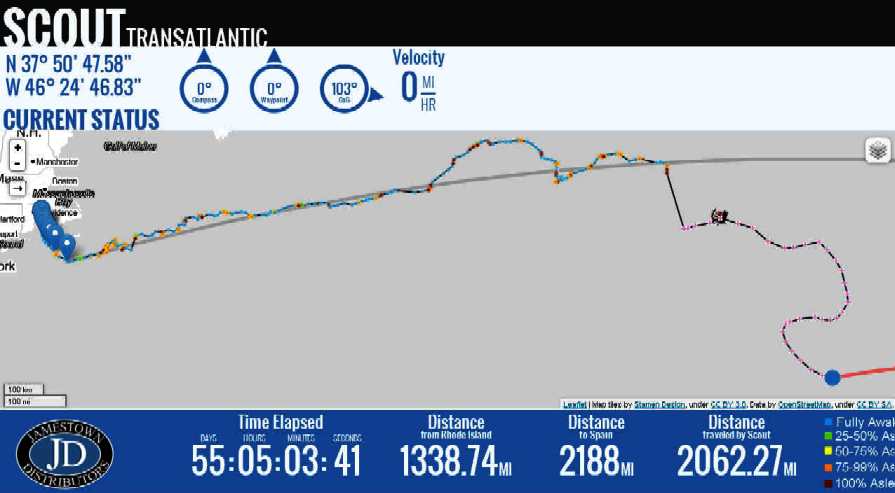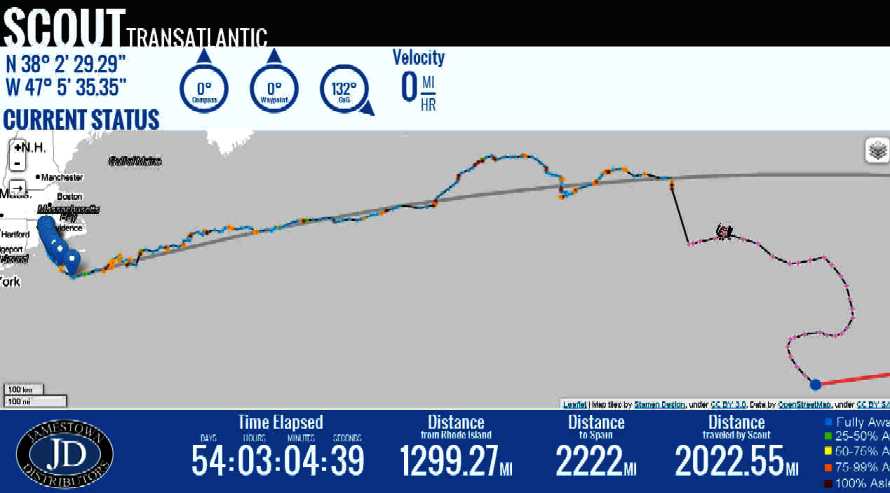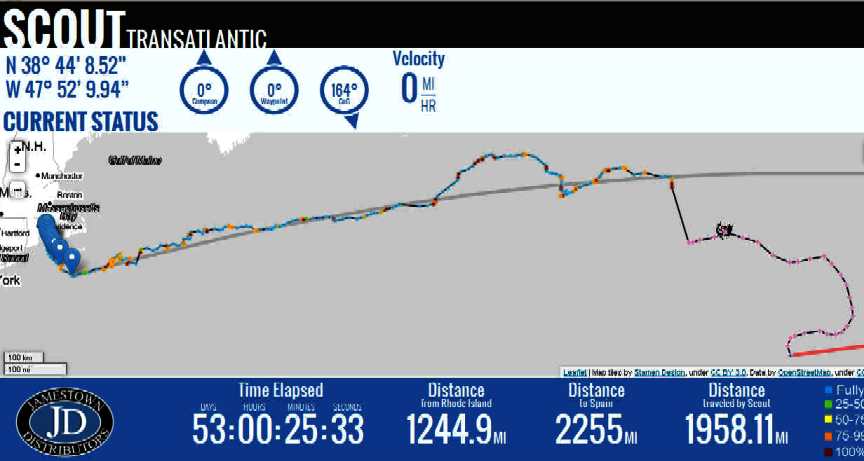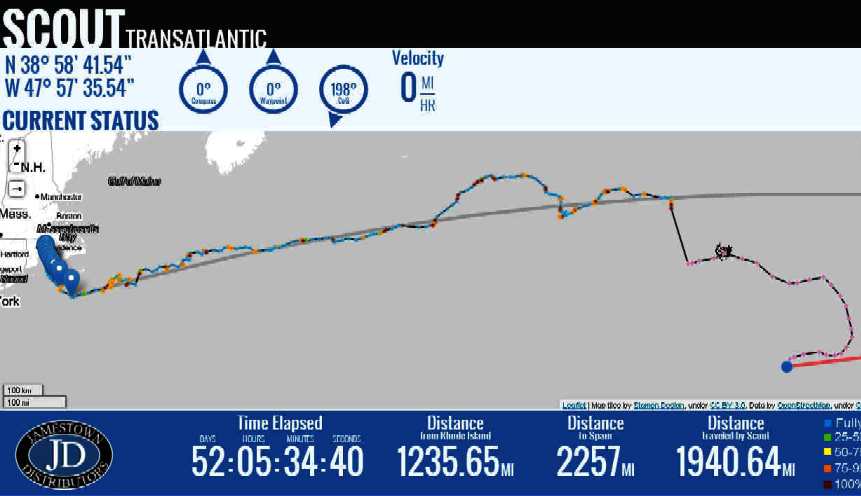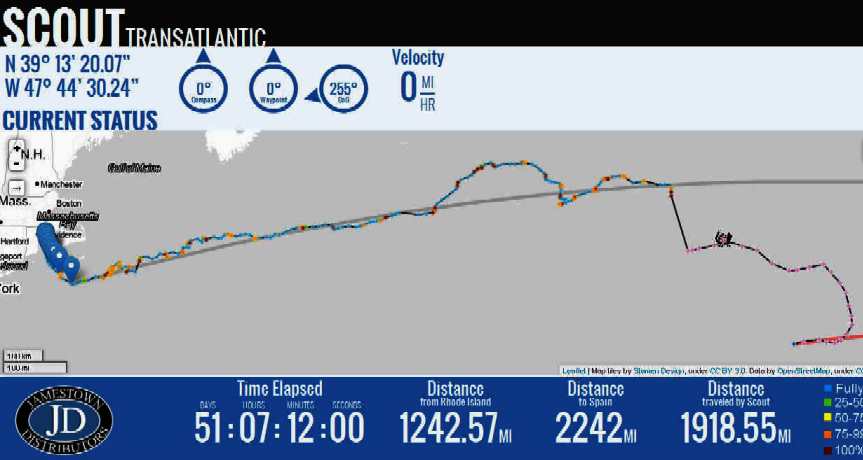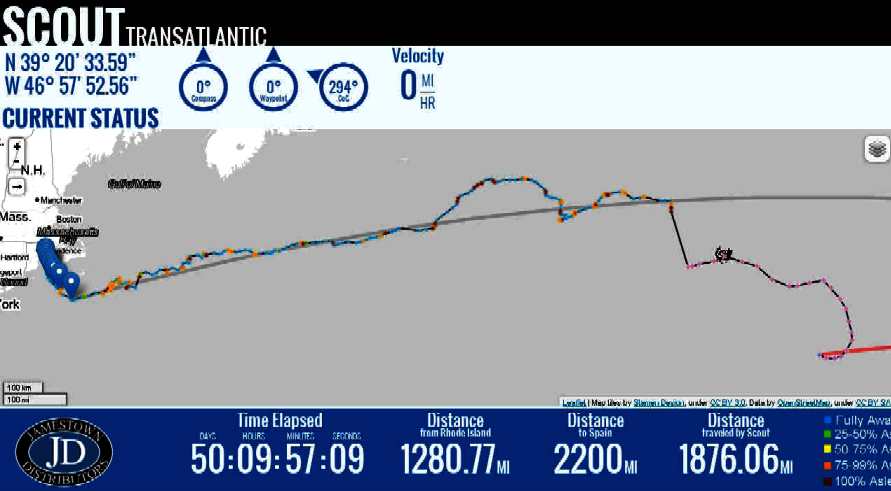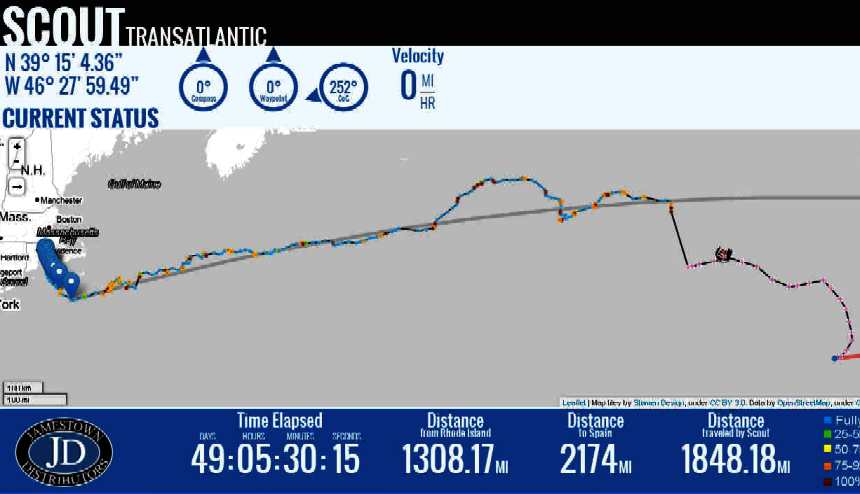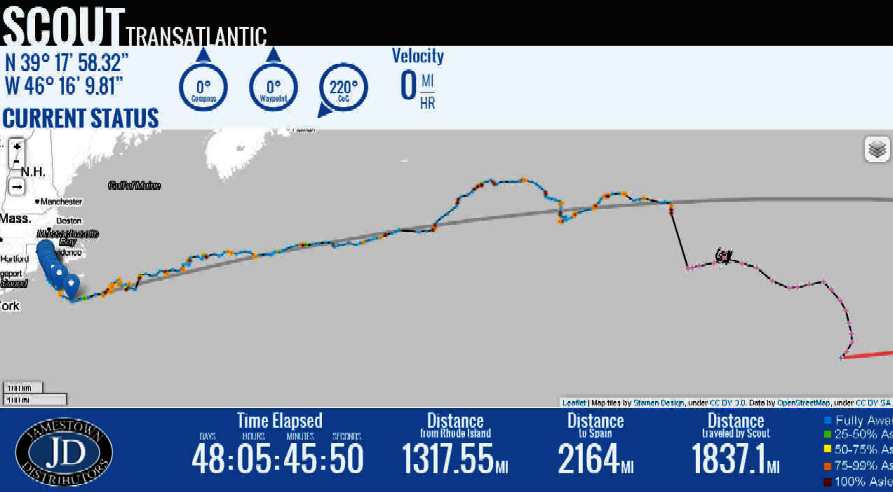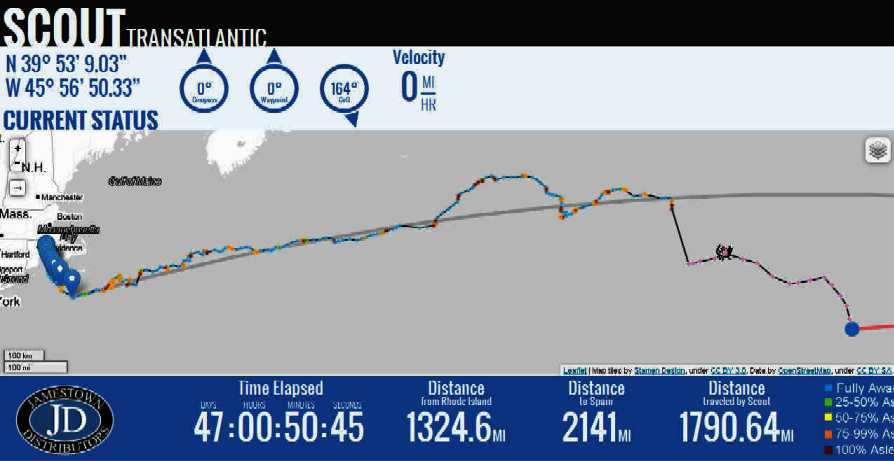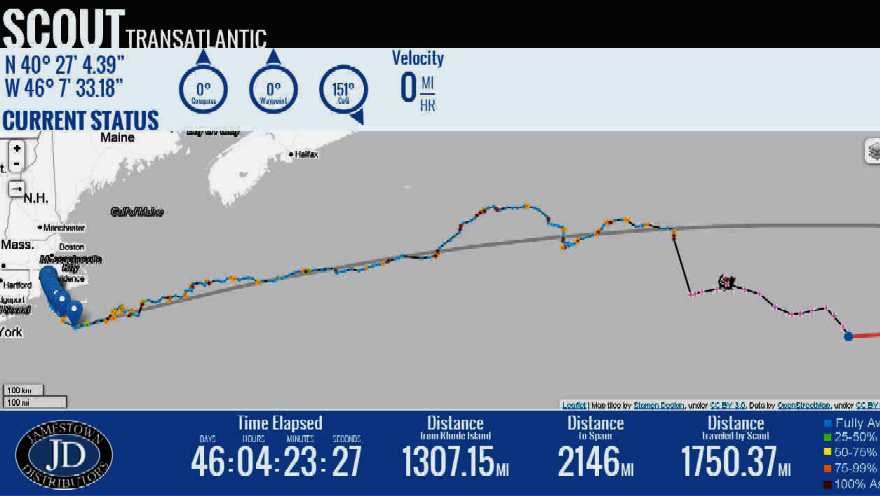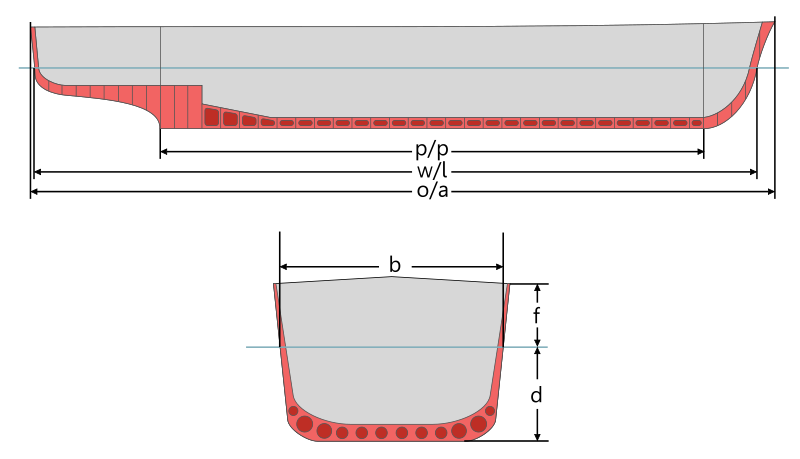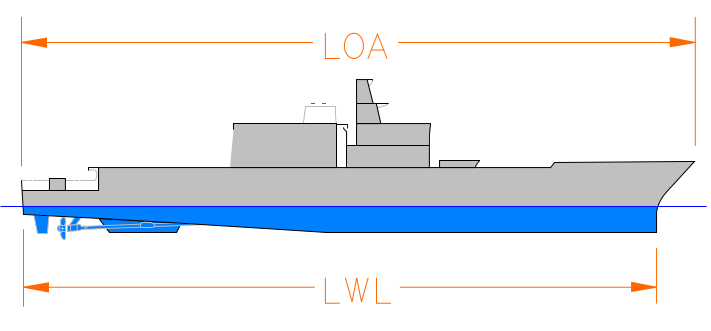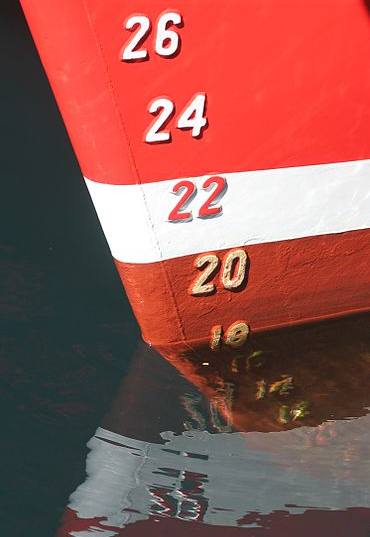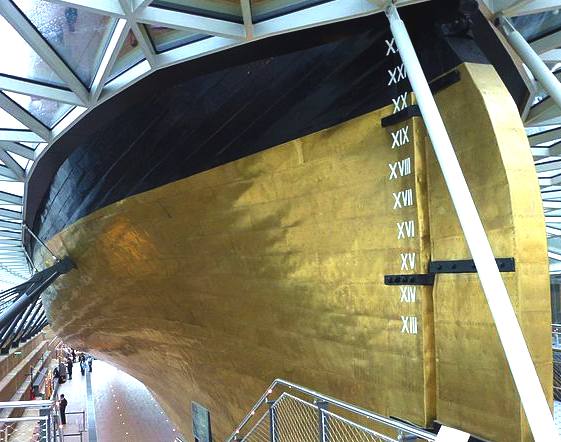|
SCOUT TRANSATLANTIC @ 60 DAYS
|
||||
|
AUTONOMOUS NEWS UPDATE 2021
Following on from the Scout Atlantic bash in 2013, in 2020, a team comprising Promare, IBM, and many other technology partners, decided to attempt to cross the Atlantic against the prevailing winds and currents. They set out to build a 100ft craft named Mayflower Autonomous Ship (MAS) for launch and an attempt, aiming for the 400th anniversary of the Pilgrim Fathers journey starting on the 6th of September 1620.
They never made that date, partly due to Covid 19, but did manage to get a hull in the water for the ceremonies in Plymouth, Devon in 2020. On the 15th June 2021, the unmanned craft departed from Plymouth in England, aiming for Plymouth, Massachusetts, USA. You can follow the journey on their blog: https://mas400.com/dashboard
MAS 400 - The fully autonomous trimaran Setting off from Plymouth, England on the 15th June 2021. There are solar panels, that presumably add to the diesel-electric setup. The idea is to be COLREGs compliant with a self learning program, as such vessels build a database. Much the same as with the current bevy of self-driving robotaxis and robotracks. The question is therefore, will ships beat trucks to the autonomous punch?
SCOUT 60th DAY UPDATE - The general consensus is that Scout has wiped out. Someone suggested that the propeller might be fouled. We'd like to know, and maybe we'll find out if the boat is recovered. It is still one hell of an achievement. Hopefully, to be built upon as, when and if the team regroups/recovers their equilibrium.
Meantime, the present drift is interesting and we will follow it just to see where the vessel finally comes to rest. At the moment Scout is a reflection on Atlantic current status, save that one would not have anticipated the snaking - but perhaps that is a "message in a bottle" type of course. If she'd been fitted with wind velocity and temperature sensors, we'd have a clearer picture. Maybe, that is for the future.
Scout continues her change in direction east towards the English Channel. Naughty Scout. We don't know what's happened, but she is not following any assigned course and we must assume the worst. Or, maybe she just became self aware (Hal). Maybe the currents are too strong to overcome - or, if the navionics have failed, could this be a robotic Mary Celeste? The 'purple' status indicators are not keyed on the tracking panel. Scout passed the 45 day milestone traveling at about 1.5 mph on a south-easterly course. She was closing on the half way point before turning west in a dramatic 'U' turn. Whatever happens now, Scout is the current distance record holder - an achievement that this team can be rightly proud. There is always another day to beat their own record. Come on Scout reset those arduinos for Spain ...... or find your way home .....
CONCEPT - Scout is a small unmanned boat of around 13 feet in length, powered by solar panels. The idea is to get across the Atlantic autonomously; that is without a crew onboard. The Scout team are using much the same gps, tracking and computer equipment as the Microtransat (sail powered) teams and other roboteers seem to favour. The design of a vessel is very important, it is what makes one vessel superior to another performance wise. Early students of boat design may enjoy learning of the various solar boat experiments we are building on. Some of which is very basic, but then basic principles are the core to a successful ship.
23 October 2013 STATS Time
Elapsed:60 DAYS: 04 HOURS: 05 MINUTES: 09 SECONDS
22 OCTOBER 2013 STATS Time
Elapsed: 59 DAYS: 02 HOURS: 59 MINUTES: 03 SECONDS
CURRENT STATUS: N 38° 32 10.78 W 45° 4 19.4 Compass 0° Waypoint 0° CoG 18°
21 OCTOBER 2013 STATS Time
Elapsed: 58 DAYS: 04 HOURS: 30 MINUTES: 42 SECONDS
20 OCTOBER 2013 STATS Time
Elapsed: 57 DAYS: 06 HOURS: 09 MINUTES: 17 SECONDS Distance
traveled by Scout 2078.85
Velocity: 1.54 mph
19 OCTOBER 2013 STATS Time
Elapsed: 56 DAYS: 05 HOURS: 18 MINUTES: 16 SECONDS Distance
traveled by Scout 2078.85
Velocity: 1.54 mph
18 OCTOBER 2013 STATS Time
Elapsed: 55 DAYS: 05 HOURS: 04 MINUTES: 41 SECONDS Distance
traveled by Scout 2062.27 Velocity: 1.54 mph
17 OCTOBER 2013 STATS Time
Elapsed:54 DAYS: 03 HOURS: 04 MINUTES: 39 SECONDS Distance
traveled by Scout 2022.55
Velocity: 1.95 mph
16 OCTOBER 2013 STATS Time
Elapsed: 53 DAYS: 00 HOURS: 25 MINUTES: 33 SECONDS
CURRENT STATUS: N 38° 44 8.52 W 47° 52 9.94 Compass 0° Waypoint 0° CoG 164°
15 OCTOBER 2013 STATS Time
Elapsed: 52 DAYS: 05 HOURS: 34 MINUTES: 40 SECONDS
14 OCTOBER 2013 STATS Time
Elapsed: 51 DAYS: 07 HOURS: 12 MINUTES: 00 SECONDS
CURRENT STATUS: N 39° 13 20.07 W 47° 44 30.24
Compass 0° Waypoint 0° CoG 255°
13 OCTOBER 2013 STATS Time Elapsed: 50 DAYS: 09 HOURS: 57 MINUTES: 09 SECONDS Distance from Rhode Island 1280.77 MI Distance to Spain 2200 MI Distance
traveled by Scout 1876.06
Velocity: 1.18 mph
12 OCTOBER 2013 STATS Time
Elapsed: 49 DAYS: 05 HOURS: 30 MINUTES: 15 SECONDS Distance
traveled by Scout 1848.18
Velocity: .92 mph
11 OCTOBER 2013 STATS (Snoopy Sloop is re-launched UK) Time
Elapsed: 48 DAYS: 05 HOURS: 45 MINUTES: 50 SECONDS Distance
traveled by Scout 1837.1
Velocity 1.19 mph
Click on the image above to follow progress live
10 OCTOBER 2013 STATS Time
Elapsed:47 DAYS: 00 HOURS: 50 MINUTES: 45 SECONDS
CURRENT STATUS: N 39° 53 9.03 W 45° 56 50.33 Compass 0° Waypoint 0° CoG 164°
9 OCTOBER 2013 STATS Time Elapsed:
46 DAYS: 04 HOURS: 23 MINUTES: 27 SECONDS Distance
traveled by Scout 1750.37
Velocity 1.5 mph
Key to phases of robotic operation
WATERLINE LENGTH - The waterline length (originally Load Waterline Length, abbreviated to LWL) is a measurement of ships and boats. The term denotes the length of the vessel at the point where it sits in the water. It excludes the total length of the boat, such as features that are out of the water. Most boats rise outwards at the bow and stern, so a boat may be quite a bit longer than its waterline length. In a ship with such raked stems, naturally the waterline length changes as the draft of the ship changes, therefore it is measured from a defined loaded condition.
DRAFTS OF A SHIP
Metric and English (Roman) bow scales
Scout Video
Make sure to visit the Scout team website at www.GoTransat.com
LINKS
https://twitter.com/ScoutTRANSAT https://www.facebook.com/ScoutTransatlantic http://www.wpri.com/on-air/green-team/ri-students-design-solar-powered-boat http://www.solarracing.org/2013/06/10/autonomous-solar-powered-boat-to-cross-the-atlantic/ http://letsmakerobots.com/node/38270 http://www.kickstarter.com/projects/601285608/scout-the-autonomous-transatlantic-boat http://www.kickstarter.com/help/school#defining_your_project http://www.kickstarter.com/start?ref=footer http://www.gotransat.com/ http://www.gotransat.com/tracking/ http://makezine.com/magazine/transatlantic-drone-takes-to-the-sea/ http://www.behance.net/gallery/SCOUT-Transatlantic/10153015 World
Sea
conditions, Temperatures
& Sunshine http://www.yellowbrick-tracking.com/ http://fishpi.org/wiki/index.php?title=The_Proof-Of-Concept_Vehicle http://fishpi.org/wiki/index.php?title=The_Prototype http://fishpi.org/wiki/index.php?title=Hull_Design http://www.raspberrypi.org/ http://international.findmespot.com/ http://www.amsat.org/
Blackcurrant 1 | Blackcurrant 2 | Catamaran Hull Design Drag | SWASH | SWATH | Trimaran
|
||||
|
This website is Copyright © 2013 Bluebird Marine Systems Ltd. The names Bluebird, Bluefish, Solar Navigator,Blueplanet Ecostar BE3, Utopia Tristar and the blue bird and fish in flight logos are trademarks. The color blue is an essential element of the marks. All other trademarks are hereby acknowledged.
|
||||

